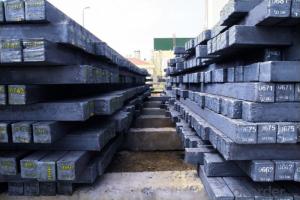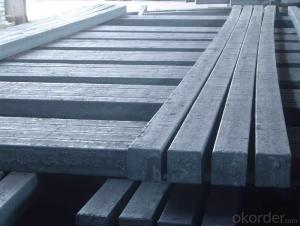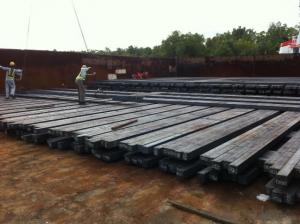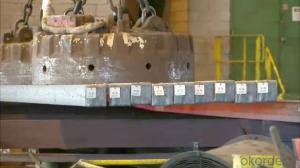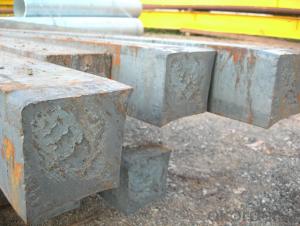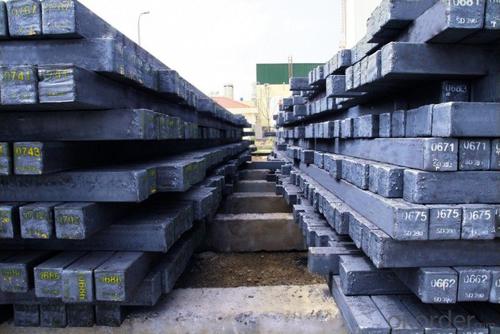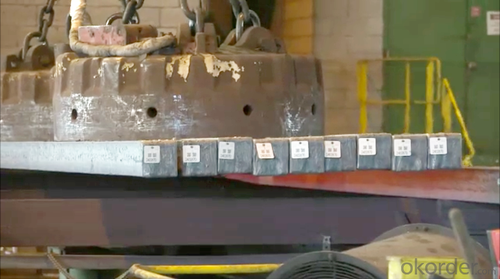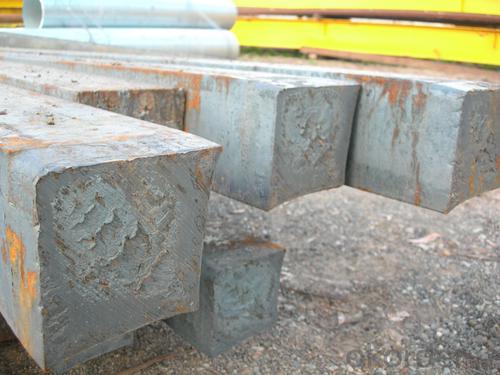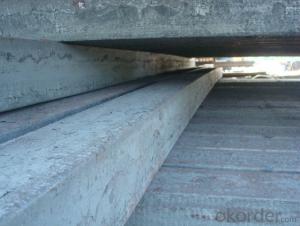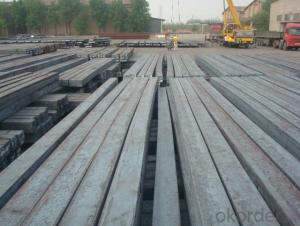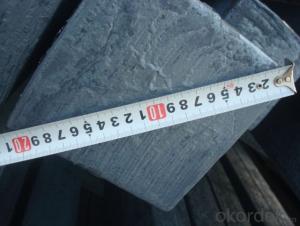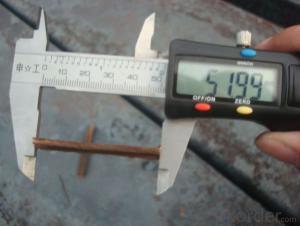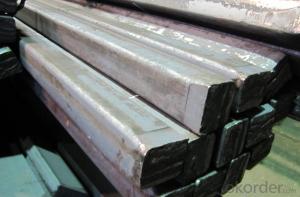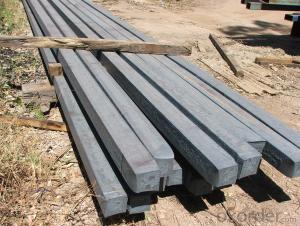Prime quality square alloy steel billet 160mm Q235
- Loading Port:
- Tianjin
- Payment Terms:
- TT OR LC
- Min Order Qty:
- 100 m.t.
- Supply Capability:
- 10000 m.t./month
OKorder Service Pledge
OKorder Financial Service
You Might Also Like
Structure of Prime quality square alloy steel billet 160mm Q235
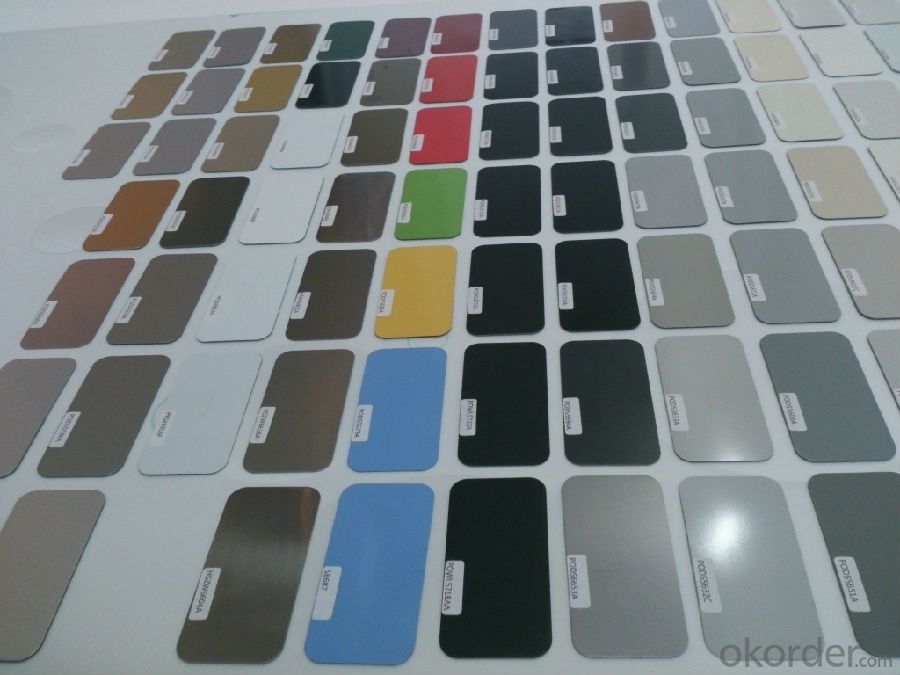
Description of Prime quality square alloy steel billet 160mm Q235
1. Prepainted steel coil is coated with organic layer, which provides higher anti-corrosion property and a longer lifespan than that of galvanized or galvalume steel sheets.
2. The base metals for prepainted steel coil consist of cold rolled, HDGI Steel, electro-galvanized and hot-dip alu-zinc coated steel. The finish coats of prepainted steel coil can be classified into groups as follows: polyester, silicon modified polyesters, polyvinylidene fluoride, high-durability polyester, etc.
3. The production process has evolved from one-coating-and-one-baking to double-coating-and-double-baking, and even three-coating-and-three-baking.
4. The color of the prepainted steel coil has a very wide selection, like orange, cream-colored, dark sky blue, sea blue, bright red, brick red, ivory white, porcelain blue, etc.
5. The prepainted steel coils can also be classified into groups by their surface textures, namely regular prepainted sheets, embossed sheets and printed sheets.

Main Feature of Prime quality square alloy steel billet 160mm Q235
Uncoated CR steel sheet
With the features of in line with the international highest standards in demension and shape, excellent surface finish and properties, the products are mainly used in home appliance and automobile industries.
Galvanized steel sheet(include HDG and EG)
With the features of good corrosion resistance, the products are mainly used in automobile, home appliance, electronics, building and machinery manufacture industries, etc.
Precoated steel sheet
With the features of enviromental protection and good processablility, long lasting surface durability, rich in colors, the products are maily used in building, home appliance and furniture industries, etc.
Applications of Prime quality square alloy steel billet 160mm Q235
Construction
Manufacture anticorrosion, industrial and civil architecture roof boarding, roof grille
Light industries
Home appliance's case, civil chimney, kitchen utensils
Auto industry
Corrosion resistant parts of cars
Agriculture
Food storage, meat and aquatic products' freezing and processing equipment
Commerce
Equipments to store and transport materials, and packing implements

Specifications of Prime quality square alloy steel billet 160mm Q235
Product | Prime quality square alloy steel billet 160mm Q235 |
Material Grade | SGCC / SGCH / DX51D+AZ, etc |
Thickness | 0.6-3.0mm |
Width | 500-1500mm |
Tolerance | Thickness: +/-0.02mm , Width:+/-2mm |
Zinc-coating | Z30-150g/m2 |
Technique | Raw material: Hot rolled steel coil --> Cold rolled_>hot dipped galvalume |
Surface | Dried, Chromated, Unoiled |
Spangle | Regular spangle , small spangle, zero spangle |
ID | 508MM 610MM |
Coil weight | 1-25MT |
Export package | Cardboard inner sleeves, Waterproof paper, galvanized steel covered and steel strip packed |
FAQ of Prime quality square alloy steel billet 160mm Q235
We have organized several common questions for our clients,may help you sincerely:
1. How Can I Visit There?
Our company is located in Tianjin City, China, near Beijing. You can fly to Tianjin Airport Directly. All our clients, from home or aboard, are warmly welcome to visit us!
2. How Can I Get Some Sample?
We are honored to offer you sample.
3. Why choose CNBM?
Our delivery time about 15-20days for standard sizes, if you have other requirements like hardness, quanity and width ,it is about 20-40days. But don't worry we also try our best for the delivery time ,because time longer and our cost is higher.
- Q: How are steel billets used in the production of automotive exhaust systems?
- Steel billets are an essential component in the production of automotive exhaust systems. These billets, which are solid blocks of steel, serve as the raw material for various parts and components of the exhaust system. The first step in using steel billets is to heat them in a furnace to a specific temperature in order to soften the steel and make it malleable. Once heated, the billets are then shaped and formed into different parts of the exhaust system, such as pipes, mufflers, and catalytic converters. This shaping process can be done through hot rolling, cold rolling, or extrusion, depending on the desired shape and properties of the component. After shaping, the steel billets are further processed to enhance their strength and durability. This can involve heat treatment processes like quenching and tempering, which improve the steel's hardness, toughness, and resistance to corrosion. These treatments ensure that the exhaust system components can withstand the harsh conditions they will be exposed to, such as high temperatures and corrosive gases. Once the steel billets have been shaped and treated, they are then assembled and welded together to form the final exhaust system. This involves joining the various components, such as pipes and mufflers, through welding techniques like arc welding or laser welding. These welding processes ensure that the components are securely connected, preventing any leaks or failures in the exhaust system. Overall, steel billets play a crucial role in the production of automotive exhaust systems by providing the necessary raw material for shaping and forming the various components. Their strength, durability, and resistance to high temperatures and corrosion make them an ideal choice for manufacturing exhaust systems that can withstand the demanding conditions of automotive use.
- Q: What are the different shapes available for steel billets?
- There are several different shapes available for steel billets, including square, round, rectangular, and hexagonal shapes.
- Q: How are steel billets marked for identification and traceability?
- Various methods are utilized to mark steel billets for identification and traceability. One prevalent approach involves the utilization of unique identification numbers or codes. These numbers or codes can be engraved or stamped onto the billet's surface, enabling easy identification. Laser engraving machines or steel stamping tools are frequently employed for this purpose. Aside from identification numbers, other significant details, such as the grade, heat number, and production date, can also be marked on the billet. These details play a crucial role in traceability, allowing for the tracking of the steel's origin and quality. Moreover, some manufacturers may choose to employ additional marking techniques, such as paint or ink marking. This may entail the use of specific colors or symbols to represent different characteristics or attributes of the billet. For example, a particular color might indicate the intended use of the steel, while a symbol may signify the manufacturer's logo or quality certification. Overall, the marking of steel billets for identification and traceability is indispensable in ensuring quality control, verifying compliance with industry standards, and facilitating efficient inventory management throughout the supply chain.
- Q: What are the potential applications of steel billets in the packaging industry?
- The packaging industry has a wide array of potential uses for steel billets. Steel drums and barrels, for example, rely heavily on steel billets for their production and are commonly used to package and transport a variety of materials like chemicals, oils, and liquids. Steel billets are also essential for manufacturing steel cans, which are widely used to package food and beverages. Steel cans are known for their exceptional durability and strength, ensuring that the contents remain well protected during transportation and storage. Additionally, steel cans provide an airtight seal, helping to maintain the freshness and quality of the packaged products. Moreover, steel billets can be utilized in the creation of steel strapping and bands, which are employed to secure and bundle packaged goods. Steel strapping is particularly advantageous due to its superior strength and resistance against breakage, making it an optimal choice for heavy-duty packaging requirements. Another notable application of steel billets in the packaging industry is in the production of wire mesh containers and pallets. These containers and pallets are commonly used in warehouses and distribution centers for storing and transporting goods. Steel billets provide the necessary strength and durability to withstand the weight and handling of various packaged materials. Furthermore, steel billets can also be employed in the manufacturing of steel tubes and pipes, which serve as structural components in packaging machinery and equipment. These tubes and pipes contribute to the stability and strength required for proper functioning and longevity of packaging machines. In conclusion, the potential applications of steel billets in the packaging industry are diverse and extensive. Whether it be for steel drums and cans, strapping and bundling, containers and pallets, or tubes and pipes, steel billets offer the essential strength, durability, and reliability necessary for effective packaging and transportation of various products.
- Q: How are steel billets used in the production of automotive braking systems?
- The production of automotive braking systems heavily relies on steel billets, which serve as a vital ingredient. These billets, essentially semi-finished steel products, act as the raw material for further processing. Typically, they are created through the casting process, in which molten steel is poured into molds and allowed to solidify. In the realm of automotive braking systems, steel billets are primarily utilized for the manufacturing of brake rotors or discs. These components play a critical role as they provide the surface on which the brake pads make contact, generating friction and ultimately halting the vehicle. Due to the intense stress and heat experienced during braking, brake rotors require a material that is strong, durable, and heat-resistant – qualities that steel possesses. Once the steel billets are acquired, they undergo a series of manufacturing processes to transform them into brake rotors. Initially, the billets are heated to a specific temperature, enhancing their malleability and making them easier to shape. Subsequently, a process known as forging is employed, subjecting the heated billets to high pressure in order to mold them into the desired form of the brake rotor. This forging process strengthens and fortifies the steel, rendering it resistant to wear and deformation. Following the forging stage, the brake rotor undergoes additional machining processes. This includes the turning of the rotor's surface to ensure it is flat and smooth, providing an even contact surface for the brake pads. Further modifications, such as drilling or slotting, may be performed to enhance heat dissipation and prevent the accumulation of gases or debris between the pad and rotor. These machining processes are vital for achieving the necessary dimensions and surface finish of the brake rotor. Once the brake rotor is manufactured, it is then assembled alongside other components of the braking system – brake calipers, pads, and hydraulic lines – to create a fully functional braking system. The utilization of steel billets in the production of brake rotors guarantees a reliable, durable, and capable braking system that can withstand the demanding conditions of automotive braking. In conclusion, steel billets are indispensable in the production of automotive braking systems, serving as the foundation for the creation of brake rotors – key components responsible for halting vehicles. Through processes such as heating, forging, and machining, the billets are transformed into robust and finely finished brake rotors. The end result is a dependable and long-lasting braking system that ensures vehicle safety and performance.
- Q: How do steel billets contribute to the manufacturing of marine equipment?
- Steel billets play a crucial role in the manufacturing of marine equipment. These billets are semi-finished products that are used as raw materials in the production of various marine components such as ship hulls, propellers, shafts, and other structural parts. One of the primary reasons steel billets are preferred in the marine industry is their excellent strength and durability. Ships and other marine equipment are subjected to harsh conditions including extreme temperatures, corrosive saltwater, and heavy loads. Steel billets, being made of high-quality steel, possess the necessary strength to withstand these challenging environments, ensuring the long-term reliability and safety of the equipment. Moreover, steel billets provide the flexibility to create complex shapes and designs required in marine equipment manufacturing. The billets can be easily molded and forged into desired shapes, allowing for the creation of intricate components with precise specifications. This versatility enables the production of different marine equipment parts that are essential for the efficient operation of vessels. Another advantage of using steel billets in marine equipment manufacturing is their corrosion resistance. Steel billets can be treated with various protective coatings or alloys to enhance their resistance to corrosion caused by exposure to seawater. This corrosion resistance is vital in preserving the integrity and longevity of marine equipment, ensuring they can withstand the harsh marine environment for extended periods. Furthermore, steel billets offer excellent weldability, making them suitable for the construction and repair of marine equipment. The ability to weld steel billets together allows for the seamless joining of different components, ensuring structural integrity and reducing the risk of failure. This welding capability facilitates the assembly and maintenance of marine equipment, enabling efficient production processes and cost-effective repairs. In summary, steel billets are essential in the manufacturing of marine equipment due to their strength, durability, versatility, corrosion resistance, and weldability. These qualities make steel billets a preferred choice for producing various marine components, ensuring the reliability, safety, and longevity of the equipment in the demanding marine environment.
- Q: What is the role of steel billets in the manufacturing of automotive frames?
- The manufacturing of automotive frames heavily relies on steel billets, which fulfill a crucial role. These billets are essentially semi-finished steel products utilized as raw material across various industrial processes. In the automotive sector, steel billets undergo a series of manufacturing steps to become automotive frames. Primarily, steel billets are chosen for their exceptional strength and durability. Their composition and mechanical properties make them ideal for supporting the weight and structural integrity of automotive frames. These frames need to endure diverse loads, shocks, and vibrations, which is where steel billets provide the necessary strength and stability. The manufacturing process commences with heating the steel billets to a specific temperature known as the forging temperature. At this temperature, the billets become pliable and can be easily shaped and manipulated. Subsequently, they are introduced into a forging press or machine, where immense pressure is employed to mold them into the desired shape of the automotive frame. Following the forging process, the frames commonly undergo heat treatment to enhance their mechanical properties and performance. This process involves heating the frames to a specific temperature and then rapidly or gradually cooling them to achieve the desired hardness, strength, and toughness. Heat treatment also aids in relieving internal stresses and enhancing the overall structural integrity of the automotive frames. Once the frames are forged and heat-treated, they go through various finishing processes, such as machining, welding, and surface treatment. Machining is executed to eliminate excess material and refine the frame's dimensions, ensuring precise specifications are met. Welding is employed to join different components of the frame together, guaranteeing their structural integrity. Additionally, surface treatments like painting or galvanizing are administered to safeguard the frames from corrosion and enhance their appearance. In summary, the indispensability of steel billets in the manufacturing of automotive frames arises from their remarkable strength, durability, and malleability. They serve as the foundation for creating robust and dependable structures capable of withstanding the demands of the automotive industry. Through processes such as forging, heat treatment, and finishing, steel billets are transformed into automotive frames that constitute the backbone of vehicles, ensuring their safety and performance on the road.
- Q: What are the different types of steel alloys used for manufacturing steel billets?
- There are several different types of steel alloys that are commonly used for manufacturing steel billets. These alloys are specifically designed to offer various properties and characteristics to meet the requirements of different applications. One commonly used steel alloy for manufacturing steel billets is carbon steel. Carbon steel is an alloy that primarily consists of iron and carbon. It is known for its strength and durability, making it suitable for a wide range of applications such as construction, automotive, and machinery. Stainless steel is another type of steel alloy that is frequently used for manufacturing steel billets. It is composed of iron, chromium, and other elements such as nickel and molybdenum. Stainless steel is highly resistant to corrosion, making it ideal for applications where exposure to moisture or harsh environments is a concern, such as marine equipment, medical instruments, and kitchen utensils. Another type of steel alloy used for manufacturing steel billets is alloy steel. Alloy steel is made by adding various alloying elements such as manganese, nickel, chromium, and vanadium to the base iron. This enhances the strength, hardness, and wear resistance of the steel, making it suitable for applications that require high durability and toughness, such as aerospace components, automotive parts, and industrial machinery. Tool steel is yet another type of steel alloy commonly used for manufacturing steel billets. It is a high-carbon alloy that contains additional elements such as tungsten, molybdenum, and vanadium. Tool steel is known for its exceptional hardness, heat resistance, and wear resistance, which makes it ideal for applications that involve cutting, drilling, and shaping, such as cutting tools, drills, and molds. In summary, the different types of steel alloys used for manufacturing steel billets include carbon steel, stainless steel, alloy steel, and tool steel. Each of these alloys offers specific properties and characteristics that make them suitable for different applications across various industries.
- Q: How do steel billets contribute to the manufacturing of furniture and fixtures?
- Due to their unique properties, steel billets are indispensable in the production of furniture and fixtures. The strength and stability they offer are essential for constructing these items, providing a solid framework that can support their weight and load-bearing capacity. This ensures that the furniture and fixtures will remain functional for an extended period of time. Additionally, the malleability of steel billets allows for the creation of intricate designs and shapes, enhancing the aesthetic appeal of furniture and fixtures. Manufacturers can take advantage of this flexibility to produce a wide range of styles and patterns that cater to different consumer preferences and interior design themes. Moreover, steel billets can be easily welded, making them perfect for joining various components together during the manufacturing process. This welding capability ensures a seamless and secure construction, ultimately improving the overall quality and durability of the furniture and fixtures. Furthermore, steel billets possess corrosion-resistant properties, making them suitable for indoor and outdoor furniture and fixtures alike. This resistance to rust and decay guarantees that these items can withstand harsh environmental conditions, preserving their appearance and structural integrity over time. In conclusion, the role of steel billets in the manufacturing of furniture and fixtures cannot be overstated. Their strength, malleability, weldability, and corrosion resistance contribute to the durability, design flexibility, and longevity of these items, making them a preferred choice for both manufacturers and consumers.
- Q: What are the main factors affecting the hardness of steel billets?
- The hardness of steel billets is primarily influenced by several factors. Firstly, the carbon content plays a crucial role in determining the hardness of steel. Higher carbon content results in greater hardness, as carbon atoms occupy interstitial spaces within the iron crystal lattice, creating stronger bonds and increasing the material's resistance to deformation. Secondly, the presence of alloying elements has a significant impact on steel hardness. Alloying elements such as chromium, molybdenum, and vanadium form solid solutions with iron, altering its crystal structure and strengthening the material. These elements promote the formation of fine and homogeneous microstructures, leading to higher hardness. The heat treatment process is another crucial factor affecting steel billet hardness. Through processes like quenching and tempering, the steel undergoes controlled heating and rapid cooling, resulting in a transformation of its crystal structure. This process, known as martensitic transformation, increases the hardness of the steel by creating a high concentration of dislocations and reducing the grain size. Additionally, the cooling rate during solidification also affects the hardness of steel billets. Rapid cooling, such as in water quenching, promotes the formation of a fine microstructure and increases hardness. Slower cooling rates, on the other hand, allow for the growth of larger grains, resulting in reduced hardness. Lastly, the presence of impurities and non-metallic inclusions can negatively impact the hardness of steel billets. These impurities can disrupt the crystal lattice, reducing the material's strength and hardness. Therefore, the purity and cleanliness of the steel composition are crucial in achieving higher hardness levels. In conclusion, the hardness of steel billets is influenced by factors such as carbon content, alloying elements, heat treatment processes, cooling rate, and the presence of impurities. Understanding and controlling these factors are essential for achieving the desired hardness properties in steel billets.
Send your message to us
Prime quality square alloy steel billet 160mm Q235
- Loading Port:
- Tianjin
- Payment Terms:
- TT OR LC
- Min Order Qty:
- 100 m.t.
- Supply Capability:
- 10000 m.t./month
OKorder Service Pledge
OKorder Financial Service
Similar products
Hot products
Hot Searches
Related keywords
